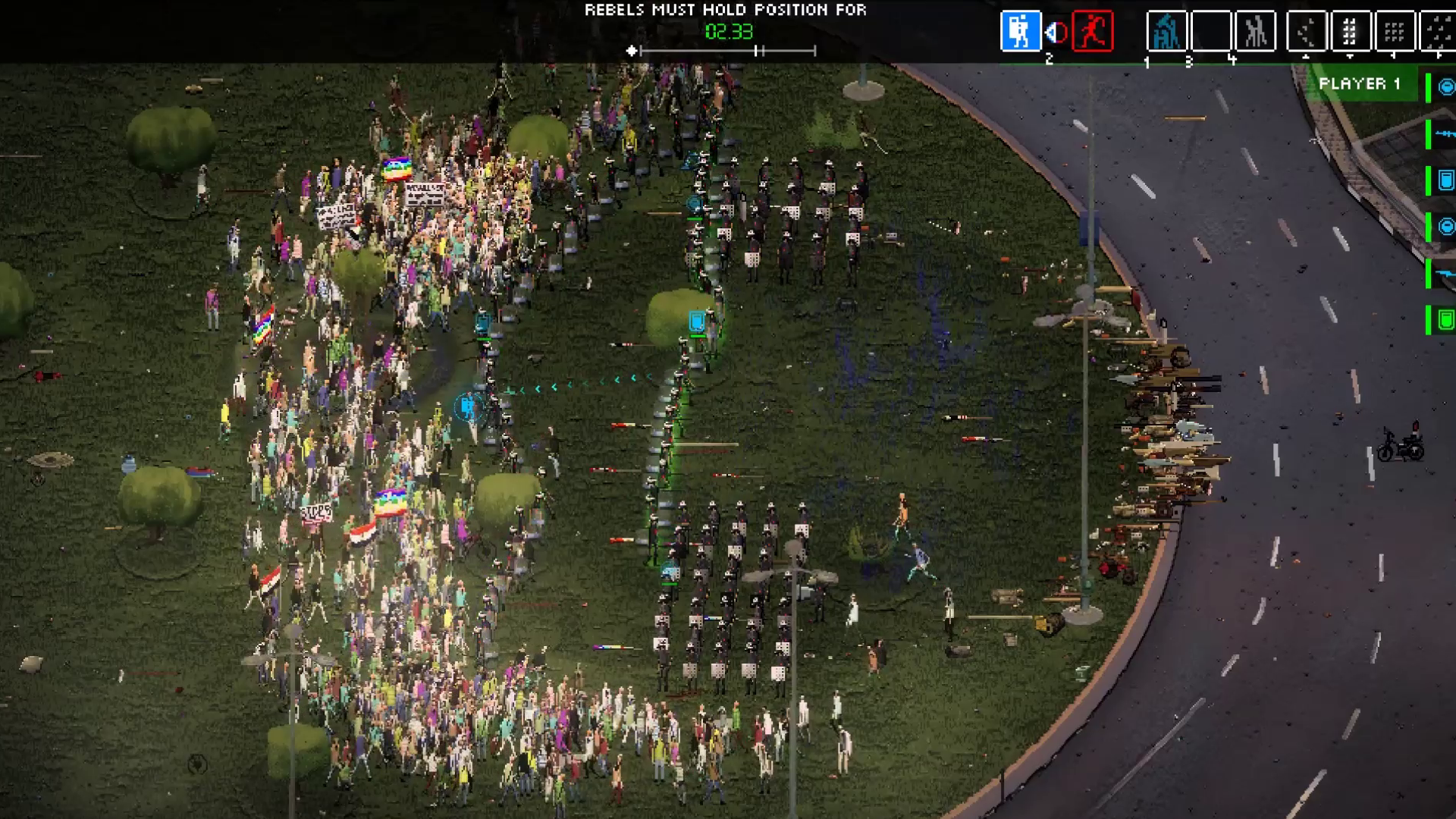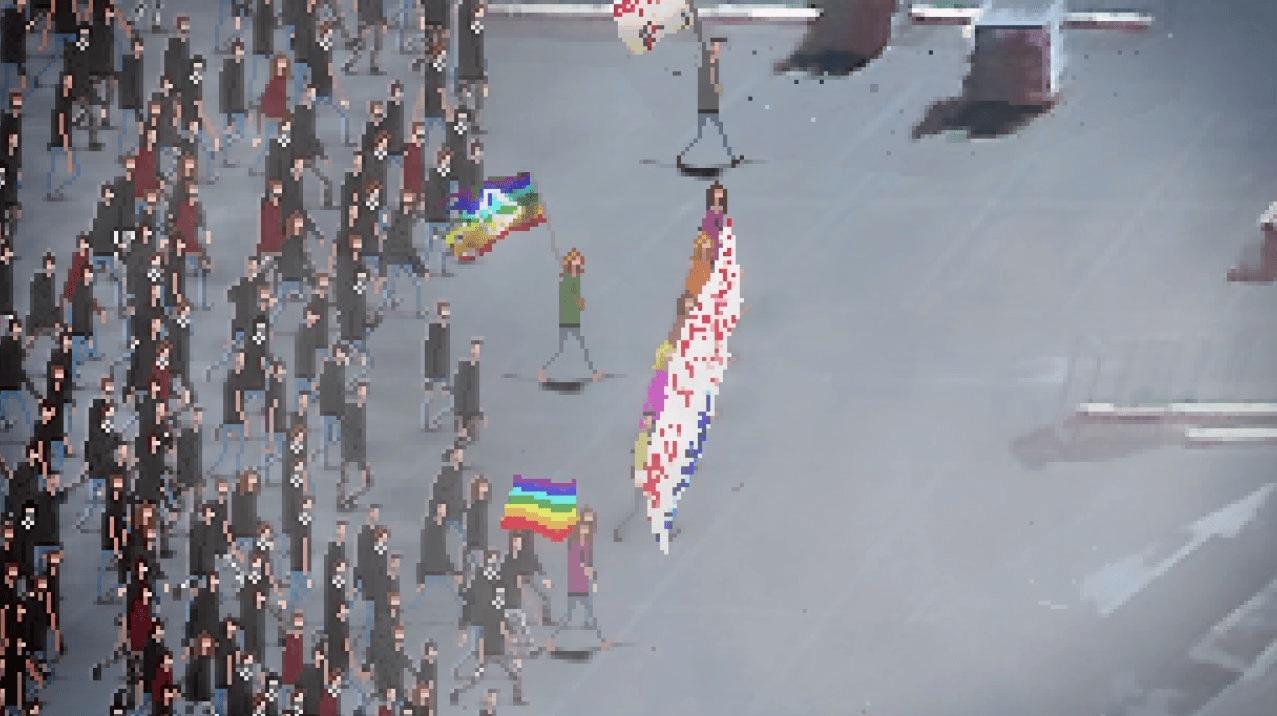
Riot: Civil Unrest is an interesting game by Leonard Menchiari that blends real-world protests from recent history with objective based strategy gameplay. The premise explained in the aforementioned introduction is the actual basis for one of the missions known as “No TAV” which was movement that was centered in Italy as far back as 1992, with escalations happening within the past few years for the sole purpose of stopping the construction of a high-speed rail line. Gameplay wise, you can begin by choosing your difficulty and you have the option to play as the protestors, or as the police, each with separate objectives depending on the mission. At the beginning of each mission, you get to set up how you’ll play. For the protesters, there are options to change the crowd division, the flag quantity, the defensive gear and the hostility of the crowd. Depending on how many flags you carry and the defensive gear you choose, it will also affect the number of people will participate in the protest. This all factors in as part of the strategy, equally so in terms of strategy, you’ll also be able to select the equipment you’ll bring with you. There are many options for items you can bring with you depending on how you want to play and what your objectives are ranging from firecrackers to agitate the opposition to a megaphone to regroup your allies.
When it comes down to actually playing, things get a little bit trickier. Some of the easier missions only really require you to click on each clump of protesters and select where you want them to go. Unfortunately, there really isn’t a tutorial to speak of to bring you up to speed on what you should be doing in what situations. For the most part, early missions are rather simplistic in nature, and those missions are quite easy to complete, even if you may receive some resistance. In other missions where you are tasked with destroying objectives, it becomes somewhat trickier due to the lack of instruction. I found that many times my rioters wouldn’t listen to me, or go where I asked them to. (Rioters these days, am I right?) I found that destroying objectives also became an arduous task as even when I chose to be a hostile rioter, which is an option you can choose during gameplay, my hostility was more generalized and I found myself just as likely to attack the police as I was destroying the objective.
At times when I was met with heavy resistance, and I used some of the equipment I brought, it would be a mixed bag as to whether or not it would do what I intended, or in the cases of the firecrackers, go where I intended them to go. At the end of each mission, it would give you a little report on how you did along with a newspaper clipping reporting on the turn of events that had just transpired. Overall, I found myself interested in the protests and the simple stories that were told between the gameplay, even a little more than the gameplay in certain missions. While the pixelated graphics aren’t anything spectacular, the care that was put into making the “cut scenes” shows a lot of forethought not just about the game but the subject material as well.

STORY
RATING: 5/10
Well, the main story of the game is obviously rioters vs police, but each level has it's own story, and without barely using words, pretty much explains the level perfectly. For example, the cutscene starts by showing you a couple of policemen gunning down some rioters. You can then conclude this won't be a peaceful riot and that the police are gonna be extremely violent.
VISUAL PRESENTATION
RATING: 8/10
The game is all pixelated, in the cutscenes the game is absolutely beautiful, ingame a bit confusing. Half of the time you won't have any idea whats going on. ( I guess they're fighting the police now, where did that molotov come from? Why is there a door flying over my screen?)
AUDIO PRESENTATION
RATING 4/10
They kinda failed here. I mean it's ok, but it could be waay better.
FINAL SCORE: 6/10
After installing the game initially I did also have a few problems starting it up which appears to be an issue the developers are aware of and looking into fixing, and I had to install the game on a different PC to get it to play without crashing consistently. Despite the downfalls of the rough AI and crashes, I do find that the game has merit due to the premise. I could see R:CU being used as a learning experience for students or for gamers looking for a different kind of strategy. As the game is still in early access there is no doubt it will only improve from here, for those looking for a new pixelated strategy, you might want to keep an eye on this one.


